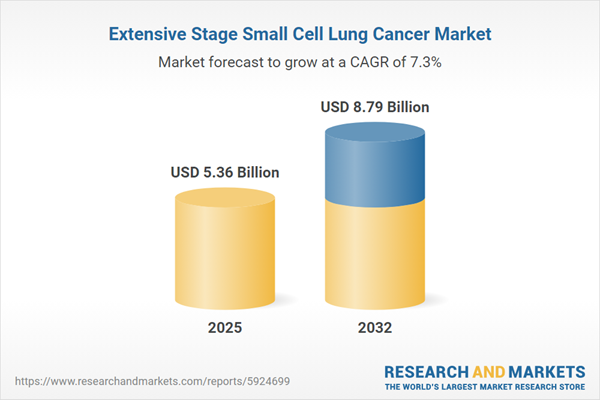Speak directly to the analyst to clarify any post sales queries you may have.
The extensive stage small cell lung cancer (ES-SCLC) market is evolving rapidly as new oncology breakthroughs, regulatory shifts, and escalating digital integration drive transformation. For leadership teams seeking enduring market strength, structured and robust market intelligence is essential to inform resilient growth strategies in a highly dynamic environment.
Market Snapshot: ES-SCLC Market Size and Growth Dynamics
The ES-SCLC market is valued at USD 5.01 billion in 2024, projected to reach USD 5.36 billion by 2025 and USD 8.79 billion by 2032. The compound annual growth rate stands at 7.27%. Industry momentum is influenced by the widespread adoption of individualized care models, evolving regulatory priorities, and the concerted push for pricing and distribution optimization. To stay competitive in both established and emerging regions, organizations must navigate increasingly complex reimbursement landscapes and strengthen supply chain strategies amid frequent regulatory developments.
Scope & Segmentation: Strategic Insights for the ES-SCLC Market
This report presents focused market intelligence for senior leaders tasked with developing strategy in the ES-SCLC sector. Detailed segmentation illuminates key opportunities and challenges across multiple operational horizons:
- Treatment Type: Analysis encompasses the spectrum from established chemotherapy to immunotherapies such as CTLA-4 and PD-1/PD-L1 inhibitors, as well as next-generation therapies that target resistance and unmet clinical needs.
- Mode of Administration: Reviews how intravenous and oral drug delivery approaches impact patient adherence, clinical workflow optimization, and flexible care delivery models.
- Prescription Type: Evaluates the implications of branded versus generic treatments on commercial strategy, cost management, patient equity, and timeline acceleration for new launches.
- Distribution Channel: Addresses the structure and agility of hospital, retail, and digital pharmacy supply channels, alongside the transformational impact of digitalization on operational responsiveness.
- End User: Tracks market penetration across hospitals, oncology clinics, and the growing home healthcare segment, highlighting evolving requirements for coordination and service innovation.
- Geographic Regions: Assesses approaches in the Americas, Europe, Middle East & Africa, and Asia-Pacific, focusing on regional regulatory frameworks, reimbursement processes, and the influence of local alliances on delivery models.
- Companies Profiled: Comparative reviews of F. Hoffmann-La Roche AG, AstraZeneca PLC, AbbVie Inc., and Amgen Inc. provide insight into innovation direction, strategic positioning, and the relationship between global and region-specific strategies.
Key Takeaways for Senior Decision-Makers
- Personalized medicine and the growing integration of immunotherapies are reshaping patient management and driving deeper alignment with individualized tumor profiles.
- Expanding use of complex regimens and sequential therapies calls for agile updates to clinical protocols and operational blueprints.
- Supply chain and regulatory differences across regions mean operational agility and localized strategies are essential for sustained performance.
- Heightened collaboration between pharma, biotech, and research sectors is enabling more rapid therapy development and expanded patient access.
- Advanced analytics and digital technologies, including artificial intelligence, improve forecasting, ensure compliance, and boost process efficiency in a dynamic oversight environment.
- Granular segmentation and adaptive resource deployment are key to executing tailored strategies across diverse oncology landscapes.
Tariff Impact on Oncology Supply Chains
Forthcoming U.S. tariffs in 2025 will raise the bar for supply chain planning within the ES-SCLC market. Leading organizations are counteracting potential disruptions by increasing local procurement, leveraging predictive analytics, and strengthening risk management. These measures ensure therapy continuity and reinforce patient care despite evolving market policies and tariff-related uncertainties.
Methodology & Data Sources
The report synthesizes insights from oncology clinicians, pharmacology experts, and payer interviews. This qualitative foundation is reinforced by extensive secondary research and real-time policy monitoring, with scenario modeling applied to enable actionable, forward-focused market projections for executive decision-makers.
Why This Report Matters to C-Suite Executives
- Equips leadership with actionable intelligence to prioritize research and development, enhance launch efficiency, and anticipate ES-SCLC market shifts.
- Identifies and addresses regulatory and operational vulnerabilities to fortify resilience and maintain organizational agility.
- Provides a structured framework for targeted segmentation and regionally responsive execution, fully aligned with the needs of the global oncology sector.
Conclusion
This report gives senior decision-makers the clear foresight needed to manage ES-SCLC’s evolving landscape, supporting sustainable strategies from clinical innovation through to successful market access.
Additional Product Information:
- Purchase of this report includes 1 year online access with quarterly updates.
- This report can be updated on request. Please contact our Customer Experience team using the Ask a Question widget on our website.
Table of Contents
3. Executive Summary
4. Market Overview
7. Cumulative Impact of Artificial Intelligence 2025
Companies Mentioned
The companies profiled in this Extensive Stage Small Cell Lung Cancer market report include:- F. Hoffmann-La Roche AG
- AstraZeneca PLC
- AbbVie Inc.
- Amgen Inc.
- Astellas Pharma Inc.
- BeOne Medicines Ltd.
- Boehringer Ingelheim GmbH
- Bristol Myers Squibb Company
- Daiichi Sankyo Company, Limited
- Eisai Co., Ltd.
- Eli Lilly & Company Ltd.
- Exelixis, Inc.
- Gilead Sciences, Inc.
- GlaxoSmithKline PLC
- Incyte Corporation
- Jazz Pharmaceuticals PLC
- Jiangsu Hengrui Pharmaceuticals Co., Ltd.
- Johnson & Johnson Services, Inc.
- Merck KGaA
- Nektar Therapeutics
- Nippon Kayaku Co.,Ltd.
- Novartis AG
- Pfizer, Inc.
- Sandoz AG
- Sanofi S.A.
- Shanghai Henlius Biotech, Inc.
- Shanghai Junshi Biosciences Co. Ltd.
- Takeda Pharmaceutical Co. Ltd.
Table Information
| Report Attribute | Details |
|---|---|
| No. of Pages | 192 |
| Published | November 2025 |
| Forecast Period | 2025 - 2032 |
| Estimated Market Value ( USD | $ 5.36 Billion |
| Forecasted Market Value ( USD | $ 8.79 Billion |
| Compound Annual Growth Rate | 7.2% |
| Regions Covered | Global |
| No. of Companies Mentioned | 29 |









